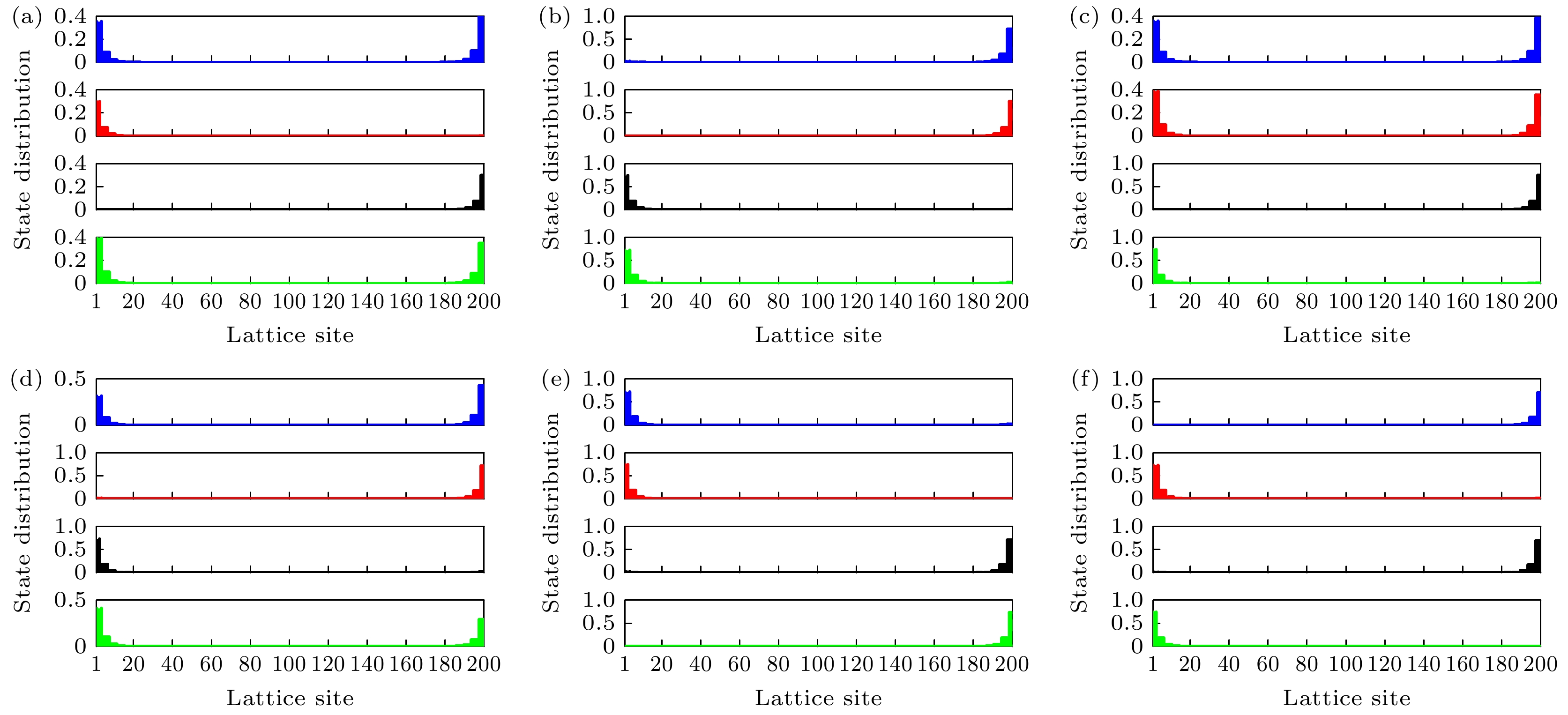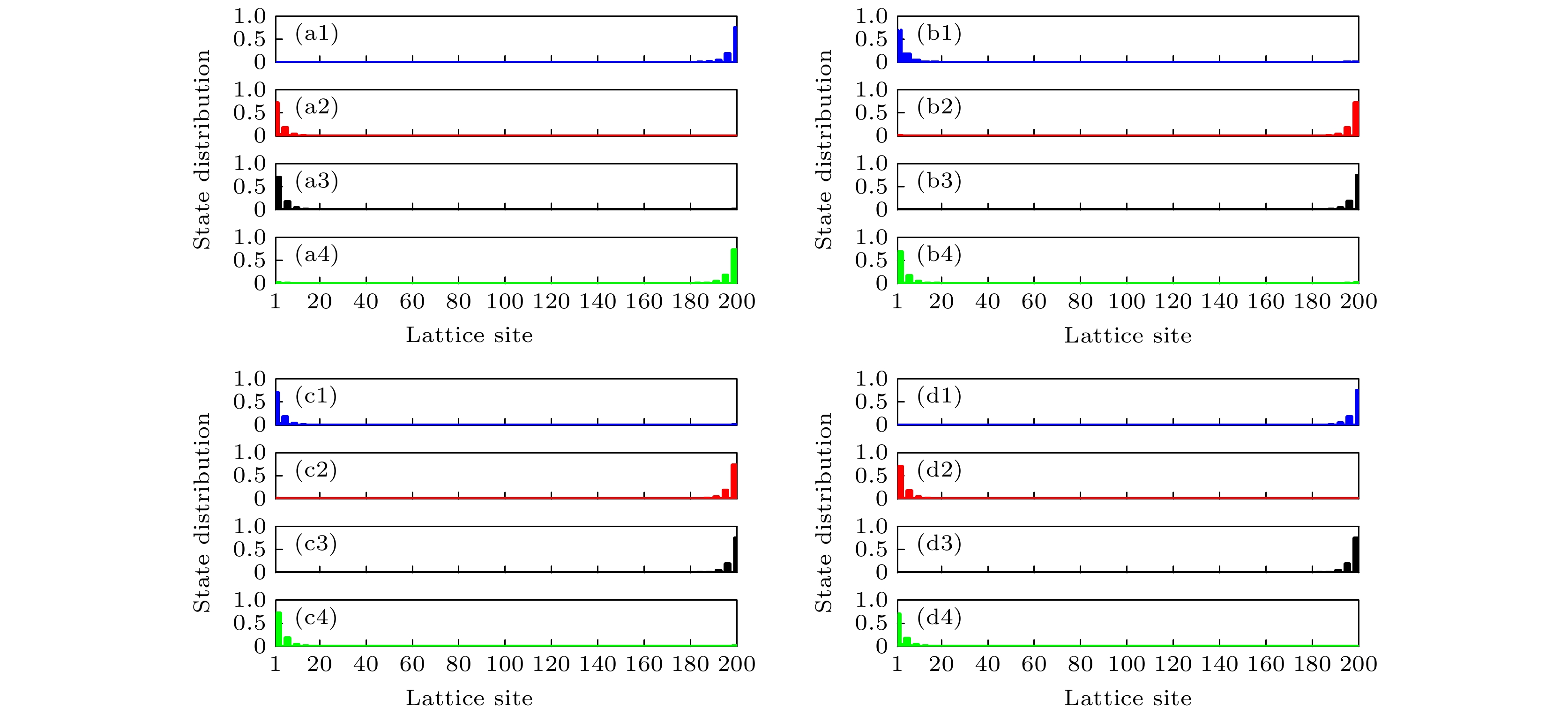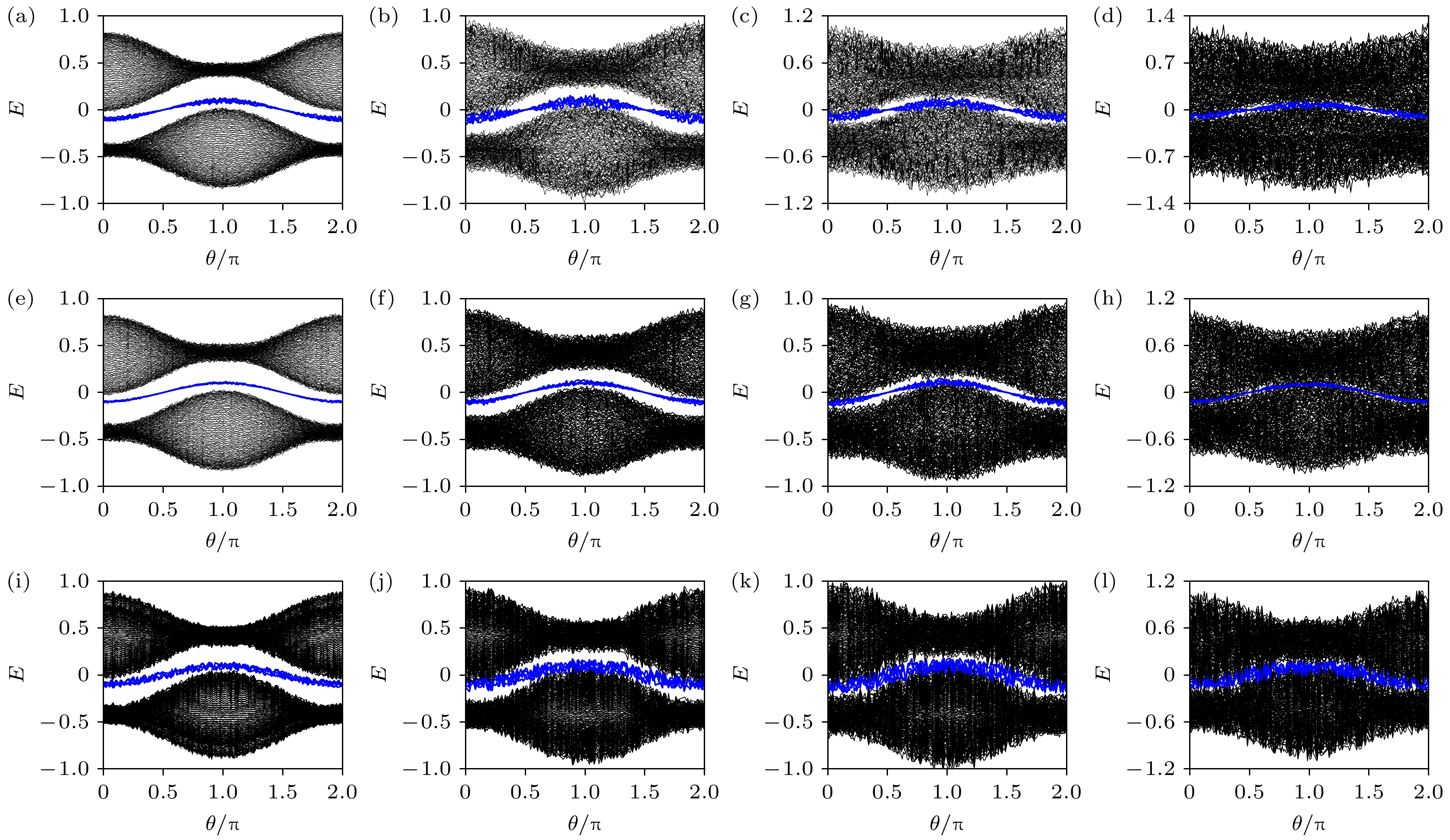-
提出了基于超导微波腔的一维晶格理论方案, 其中包含两种不同的微波腔晶胞, 通过磁通量子比特调控晶胞之间的耦合, 使反旋波项与拓扑超导体中的p-波超导配对项相映射, 实现具有p-波超导配对项的一维超导微波腔晶格系统, 进而模拟和研究其中的拓扑绝缘体特性. 结果发现, p-波超导配对项可以对系统的拓扑量子态进行调制, 可以实现四个边缘态的拓扑量子信息传输通道. 此外, 当p-波超导配对项和次近邻作用调制时, 可以发现能带发生波动现象, 从而诱导产生新的能带, 但边缘态的简并性保持稳定, 这可以实现多个拓扑量子态传输路径; 然而, 当调控超过阈值时, 系统的能隙将闭合, 使边缘态湮灭在新的能带中. 另外, 当考虑系统存在缺陷时, 可以发现缺陷强度较小时, 边缘态产生微小的波动, 但可以清晰地区分, 说明其具有鲁棒性; 当缺陷强度超过阈值时, 边缘态和能带将导致无规则波动, 使边缘态融入能带中. 本文的研究结果具有重要的理论价值和实际意义, 未来可以应用在量子光学和量子信息处理中.In this work, a one-dimensional lattice theory scheme is proposed based on superconducting microwave cavity, which includes two different types of microwave cavity unit cells. The coupling between the unit cells is controlled by flux qubits to simulate and study their topological insulator characteristics. Specifically, by mapping the counter-rotating wave terms into the p-wave superconducting pairing term, a one-dimensional superconducting microwave cavity lattice scheme with a p-wave superconducting pairing term is obtained. It is found that the p-wave superconducting pairing term can modulate the topological quantum state of the system, allowing the topological quantum information transmission channels with four edge states to be created. In addition, when the p-wave superconducting pairing term interacts with the nearest-neighbor, the energy band undergoes fluctuations, thus inducing new energy bands to be generated, but the degeneracy of the edge states remains stable, which can realize the multiple topological quantum state transmission paths. However, when its regulation exceeds the threshold, the energy gap of the system will close, causing the edge states to annihilate in a new energy band. Furthermore, with defects considered to exist in the system, when the strength of the defect is small, the edge state produces small fluctuations, but it can be clearly distinguished, showing its robustness. When the strength of the defect exceeds the threshold, the edge state and energy band will cause irregular fluctuations, allowing the edge state to integrate into an energy band. Our research results have important theoretical value and practical significance, and can be applied to quantum optics and quantum information processing in the future.
-
Keywords:
- quantum optics /
- superconducting quantum circuits /
- topological insulators /
- quantum states
[1] Qi X L, Zhang S C 2011 Rev. Mod. Phys. 83 1057
 Google Scholar
Google Scholar
[2] Hasan M Z, Kane C L 2010 Rev. Mod. Phys. 82 3045
 Google Scholar
Google Scholar
[3] Bansil A, Lin H, Das T 2016 Rev. Mod. Phys. 88 021004
 Google Scholar
Google Scholar
[4] Chiu C K, Teo J C Y, Schnyder A P, Ryu S 2016 Rev. Mod. Phys. 88 035005
 Google Scholar
Google Scholar
[5] Xu Z, Zhang Y, Chen S 2017 Phys. Rev. A 96 013606
 Google Scholar
Google Scholar
[6] Li L, Xu Z, Chen S 2014 Phys. Rev. B 89 085111
 Google Scholar
Google Scholar
[7] Li L, Chen S 2015 Phys. Rev. B 92 085118
 Google Scholar
Google Scholar
[8] Mei F, Zhu S L, Zhang Z M, Oh C H, Goldman N 2012 Phys. Rev. A 85 013638
 Google Scholar
Google Scholar
[9] Wray L A, Xu V, Xia Y, Hsieh D, Fedorov A V, SanHor Y, Cava R J, Bansil A, Lin H, Hasan M Z 2011 Nat. Phys. 7 32
 Google Scholar
Google Scholar
[10] Malki M, Uhrig G S 2017 Phys. Rev. B 95 235118
 Google Scholar
Google Scholar
[11] Chitov G Y 2018 Phys. Rev. B 97 085131
 Google Scholar
Google Scholar
[12] Agrapidis C E, van den Brink J, Nishimoto S 2019 Phys. Rev. B 99 224418
 Google Scholar
Google Scholar
[13] Braginskii V B, Manukin A B 1967 Sov. Phys. JETP 25 653
[14] Aspelmeyer M, Kippenberg T J, Marquardt F 2014 Rev. Mod. Phys 86 1391
 Google Scholar
Google Scholar
[15] Liu Y L, Wang C, Zhang J, Liu Y X 2018 Chin. Phys. B 27 024204
 Google Scholar
Google Scholar
[16] Weis S, Riviere R, Deleglise S, Gavartin E, Arcizet O, Schliesser A, Kippenberg T J 2010 Science 330 1520
 Google Scholar
Google Scholar
[17] Martin I, Shnirman A, Lin T, Zoller P 2004 Phys. Rev. B 69 125339
 Google Scholar
Google Scholar
[18] Huang S M, Agarwal G S 2010 Phys. Rev. A 81 033830
 Google Scholar
Google Scholar
[19] Wang K, Yu Y F, Zhang Z M 2019 Phys. Rev. A 100 053832
 Google Scholar
Google Scholar
[20] Wei W Y, Yu Y F, Zhang Z M 2018 Chin. Phys. B 27 034204
 Google Scholar
Google Scholar
[21] Xiao Y, Yu Y F, Zhang Z M 2014 Opt. Express 22 17979
 Google Scholar
Google Scholar
[22] Wang Y P, Zhang Z C, Yu Y F, Zhang Z M 2019 Chin. Phys. B 28 014202
 Google Scholar
Google Scholar
[23] You J Q, Nori F 2011 Nature 474 589
 Google Scholar
Google Scholar
[24] Massel F, Heikkil T T, Pirkkalainen J M, Cho S U, Saloniemi H, Hakonen P J, Sillanpää M A 2011 Nature 480 351
 Google Scholar
Google Scholar
[25] Teufel J D, Li D, Allman M S, Cicak K, Sirois A J, Whittaker J D, Simmonds R W 2011 Nature 471 204
 Google Scholar
Google Scholar
[26] Zhang Z C, Wang Y P, Yu Y F, Zhang Z M 2019 Ann. Phys. 531 1800461
 Google Scholar
Google Scholar
[27] Wang Y P, Zhang Z C, Yu Y F, Zhang Z M 2019 Laser Phys. Lett. 16 015205
 Google Scholar
Google Scholar
[28] Devoret M H, Schoelkopf R J 2013 Science 339 1169
 Google Scholar
Google Scholar
[29] Wang Y P, Zhang Z C, Yu Y F, Zhang Z M 2018 J. Phys. B: At. Mol. Opt. Phys. 51 175504
 Google Scholar
Google Scholar
[30] Roque T F, Peano V, Yevtushenko O M, Marquardt F 2017 New J. Phys. 19 013006
 Google Scholar
Google Scholar
[31] Wan L L, Lü X Y, Gao J H, Wu Y 2017 Opt. Express 25 017364
 Google Scholar
Google Scholar
[32] Wang W, Wang Y P 2022 Acta Phys. Sin. 71 194203
 Google Scholar
Google Scholar
[33] Qi L, Yan Y, Wang G L, Zhang S, Wang H F 2019 Phys. Rev. B 100 062323
 Google Scholar
Google Scholar
[34] Xu X W, Zhao Y J, Wang H, Chen A X, Liu Y X 2022 Front. Phys. 9 813801
 Google Scholar
Google Scholar
[35] 刘浪, 王一平 2022 物理学报 71 224202
 Google Scholar
Google Scholar
Liu L, Wang Y P 2022 Acta Phys. Sin. 71 224202
 Google Scholar
Google Scholar
[36] Mei F, Xue Z Y, Zhang D W, Tian L, Lee C, Zhu S L 2016 Quantum Sci. Technol. 1 015006
 Google Scholar
Google Scholar
[37] Koch J, Houck A A, Le Hur K, Girvin S M 2010 Phys. Rev. A 82 043811
 Google Scholar
Google Scholar
[38] Mei F, You J B, Nie W, Fazio R, Zhu S L, Kwek L C 2015 Phys. Rev. A 92 041805
 Google Scholar
Google Scholar
[39] Cao J, Yi X X, Wang H F 2020 Phys. Rev. A 102 032619
 Google Scholar
Google Scholar
[40] Cai W, Han J, Mei F, Yuan X Z, Sun L Y 2019 Phys. Rev. Lett. 123 080501
 Google Scholar
Google Scholar
[41] Chatterjee P, Pradhan S, Nandy A K, Saha A 2023 Phys. Rev. B 107 085423
 Google Scholar
Google Scholar
[42] Tong X, Meng Y M, Jiang X, Lee C, de Moraes Neto G D, Gao X L 2021 Phys. Rev. B 103 104202
 Google Scholar
Google Scholar
-
图 1 (a)基于超导微波腔组成的一维晶格系统, $Q_{1}$($Q_{2}$)是晶胞之间的耦合磁通量子比特, $g_{1}$($g_{2}$)表示$a_{n}$($b_{n}$)和$b_{n}$($a_{n+1}$)的耦合参数, T表示$a_{n}$和$a_{n+1}$($b_{n}$和$b_{n+1}$)的耦合参数; (b) $a_{n}$和$b_{n}$耦合在一个频率可调的控制场上, $g_{1}$($g_{2}$) 可以通过磁通量子比特外部磁通调控, T通过电容C耦合调制
Fig. 1. (a) Schematic of the 1D superconducting microwave cavity lattice system, $Q_{1}$($Q_{2}$) is the coupling flux qubit between the unit cell, $a_n$ and $b_n$ ($b_n $ and $a_{n+1}$) coupling coefficient is $g_{1}$($g_{2}$), $a_n$ and $a_{n+1}$ ($b_n$ and $b_{n+1}$) coupling coefficient is T; (b) $a_{n}$ and $b_{n}$ are connected in a tunable frequency field, $g_{1}$($g_{2}$) can be modulated by the external flux of qubits, T is modulated by the capacitance C coupling.
图 2 (a)系统能谱与晶格数目的关系; (b)蓝色和(c)红色边缘态的概率分布图; 其中$\widetilde{G}_{12}=0.15, \widetilde{G}_{24}=0.3$和晶格数$N=100$
Fig. 2. (a) Energy spectrum of the system via the lattice numbers; (b), (c) probability distributions of (b) blue and (c) red edge states. $\widetilde{G}_{12}=0.15, \widetilde{G}_{24}=0.3$ and lattice size $N=100$.
图 3 系统能谱与晶格数目的关系 (a) $2\widetilde{G}_{11}=\widetilde{G}_{23}=0.003$; (b) $2\widetilde{G}_{11}=\widetilde{G}_{23}=0.03$; (c) $2\widetilde{G}_{11}=\widetilde{G}_{23}=0.06$; (d) $2\widetilde{G}_{11}=$ $ \widetilde{G}_{23}=0.15 $; (e) $2\widetilde{G}_{11}=\widetilde{G}_{23}=0.165$; (f) $2\widetilde{G}_{11}=\widetilde{G}_{23}=2.1$; 其他参数为$\widetilde{G}_{12}=0.15, \widetilde{G}_{24}=0.3$和晶格数$N=200$
Fig. 3. Energy spectrum of the system via the lattice numbers: (a) $2\widetilde{G}_{11}=\widetilde{G}_{23}=0.003$; (b) $2\widetilde{G}_{11}=\widetilde{G}_{23}=0.03$; (c) $2\widetilde{G}_{11}= $$\widetilde{G}_{23}=0.06 $; (d) $2\widetilde{G}_{11}=\widetilde{G}_{23}=0.15$; (e) $2\widetilde{G}_{11}=\widetilde{G}_{23}=0.165$; (f) $2\widetilde{G}_{11}=\widetilde{G}_{23}=2.1$. Other parameters are $ \widetilde{G}_{12}=0.15,$ $ \widetilde{G}_{24}=0.3$ and lattice size $N=200$.
图 4 4个不同边缘态的概率分布图 (a) $2\widetilde{G}_{11}=\widetilde{G}_{23}=0.003$; (b) $2\widetilde{G}_{11}=\widetilde{G}_{23}=0.006$; (c) $2\widetilde{G}_{11}=\widetilde{G}_{23}=0.009$; (d) $2\widetilde{G}_{11}= $ $ \widetilde{G}_{23}=0.015$; (e) $2\widetilde{G}_{11}=\widetilde{G}_{23}=0.021$; (f) $2\widetilde{G}_{11}=\widetilde{G}_{23}=0.027$; 其他参数为$\widetilde{G}_{12}=0.15$, $\widetilde{G}_{24}=0.3$和晶格数$N=200$
Fig. 4. State distributions of four different edge states: (a) $2\widetilde{G}_{11}=\widetilde{G}_{23}=0.003$; (b) $2\widetilde{G}_{11}=\widetilde{G}_{23}=0.006$; (c) $2\widetilde{G}_{11}= $ $ \widetilde{G}_{23}=0.009$; (d) $2\widetilde{G}_{11}=\widetilde{G}_{23}=0.015$; (e) $2\widetilde{G}_{11}=\widetilde{G}_{23}=0.021$; (f) $2\widetilde{G}_{11}=\widetilde{G}_{23}=0.027$. Other parameters are $\widetilde{G}_{12}=0.15$, $\widetilde{G}_{24}=0.3$ and lattice size $N=200$.
图 5 系统能谱与相位的关系 (a) $2\widetilde{G}_{11}=\widetilde{G}_{23}=0.1,\; T=0$; (b) $2\widetilde{G}_{11}=\widetilde{G}_{23}=0.1,\; T=0.05$; (c) $2\widetilde{G}_{11}=\widetilde{G}_{23}=0.08(1+ $$ \cos\theta),\; T=0$; 其他参数为$\widetilde{G}_{12}=0.2$, $\widetilde{G}_{24}=0.4$和晶格数$N=200$
Fig. 5. Energy spectrum of the system via the phase: (a) $2\widetilde{G}_{11}=\widetilde{G}_{23}=0.1,\; T=0$; (b) $2\widetilde{G}_{11}=\widetilde{G}_{23}= 0.1,\; T=0.05$; (c) $2\widetilde{G}_{11}=\widetilde{G}_{23}=0.08(1+\cos\theta),\; T=0$. Other parameters are $\widetilde{G}_{12}=0.2$, $\widetilde{G}_{24}=0.4$ and lattice size $N=200$.
图 6 系统能谱与相位的关系 (a) $2\widetilde{G}_{11}=\widetilde{G}_{23}=0.08$; (b) $2\widetilde{G}_{11}=\widetilde{G}_{23}=0.16$; (c) $2\widetilde{G}_{11}=\widetilde{G}_{23}=0.24$; (d) $2\widetilde{G}_{11}= $ $\widetilde{G}_{23}=0.32$; 其他参数为$\widetilde{G}_{12}=0.2$, $\widetilde{G}_{24}=0.4$, $T=0.1$和晶格数$N=200$
Fig. 6. Energy spectrum of the system via the phase: (a) $2\widetilde{G}_{11}=\widetilde{G}_{23}=0.08$; (b) $2\widetilde{G}_{11}=\widetilde{G}_{23}=0.16$; (c) $2\widetilde{G}_{11}=\widetilde{G}_{23}=0.24$; (d) $2\widetilde{G}_{11}=\widetilde{G}_{23}=0.32$. Other parameters are $\widetilde{G}_{12}=0.2$, $\widetilde{G}_{24}=0.4$, $T=0.1$ and lattice size $N=200$.
图 7 系统能谱与相位的关系 (a) $T=0.1$; (b) $T=0.2$; (c) $T=0.3$; (d) $T=3$; 其他参数为$\widetilde{G}_{12}=0.2$, $\widetilde{G}_{24}=0.4$, $2\widetilde{G}_{11}= \widetilde{G}_{23}=0.04$和晶格数$N=200$
Fig. 7. Energy spectrum of the system via the phase: (a) $T=0.1$; (b) $T=0.2$; (c) $T=0.3$; (d) $T=3$. Other parameters are $\widetilde{G}_{12}=0.2$, $\widetilde{G}_{24}=0.4$, $2\widetilde{G}_{11}=\widetilde{G}_{23}=0.04$ and lattice size $N=200$.
图 8 4个不同边缘态的分布图 (a) $\theta=\pi/2$, $2\widetilde{G}_{11}=\widetilde{G}_{23}=0.08$; (b) $\theta=\pi/2$, $2\widetilde{G}_{11}=\widetilde{G}_{23}=0.1$; (c) $\theta=3\pi/2$, $2\widetilde{G}_{11}= $ $ \widetilde{G}_{23}=0.08$; (d) $\theta=3\pi/2$, $2\widetilde{G}_{11}=\widetilde{G}_{23}=0.1$. 其他参数为$T=0.1$, $\widetilde{G}_{12}=0.2$, $\widetilde{G}_{24}=0.4$和晶格数$N=200$
Fig. 8. State distributions of four different edge states: (a) $\theta=\pi/2$, $2\widetilde{G}_{11}=\widetilde{G}_{23}=0.08$; (b) $\theta=\pi/2$, $2\widetilde{G}_{11}=\widetilde{G}_{23}= $$ 0.1$; (c) $\theta=3\pi/2$, $2\widetilde{G}_{11}=\widetilde{G}_{23}=0.08$; (d) $\theta=3\pi/2$, $2\widetilde{G}_{11}=\widetilde{G}_{23}=0.1$. Other parameters are $T=0.1$, $\widetilde{G}_{12}=0.2$, $\widetilde{G}_{24}=0.4$ and lattice size $N=200$.
图 9 系统能谱与随机缺陷的关系图 (a) $\omega=0.1$, $\nu=\tau=0$; (b) $\omega=0.3$, $\nu=\tau=0$; (c) $\omega=0.5$, $\nu=\tau=0$; (d) $\omega=0.7$, $\nu=\tau=0$; (e) $\nu=0.1$, $\omega=\tau=0$; (f) $\nu=0.2$, $\omega=\tau=0$; (g) $\nu=0.3$, $\omega=\tau=0$; (h) $\nu=0.4$, $\omega=\tau=0$; (i) $\tau=0.1$, $\omega=\nu=0$; (j) $\tau=0.2$, $\omega=\nu=0$; (k) $\tau=0.3$, $\omega=\nu=0$; (l) $\tau=0.4$, $\omega=\nu=0$; 其他参数为$\widetilde{G}_{12}=0.2$, $\widetilde{G}_{24}=0.4$, $2\widetilde{G}_{11}=\widetilde{G}_{23}=0.04$, $T=0.1$和晶格数$N=200$
Fig. 9. Energy spectrum of the system via the random defects: (a) $\omega=0.1$, $\nu=\tau=0$; (b) $\omega=0.3$, $\nu=\tau=0$; (c) $\omega=0.5$, $\nu=\tau=0$; (d) $\omega=0.7$, $\nu=\tau=0$; (e) $\nu=0.1$, $\omega=\tau=0$; (f) $\nu=0.2$, $\omega=\tau=0$; (g) $\nu=0.3$, $\omega=\tau=0$; (h) $\nu=0.4$, $\omega=\tau=0$; (i) $\tau=0.1$, $\omega=\nu=0$; (j) $\tau=0.2$, $\omega=\nu=0$; (k) $\tau=0.3$, $\omega=\nu=0$; (l) $\tau=0.4$, $\omega=\nu=0$. Other parameters are $\widetilde{G}_{12}=0.2$, $\widetilde{G}_{24}=0.4$, $2\widetilde{G}_{11}=\widetilde{G}_{23}=0.04$, $T=0.1$ and lattice size $N=200$.
-
[1] Qi X L, Zhang S C 2011 Rev. Mod. Phys. 83 1057
 Google Scholar
Google Scholar
[2] Hasan M Z, Kane C L 2010 Rev. Mod. Phys. 82 3045
 Google Scholar
Google Scholar
[3] Bansil A, Lin H, Das T 2016 Rev. Mod. Phys. 88 021004
 Google Scholar
Google Scholar
[4] Chiu C K, Teo J C Y, Schnyder A P, Ryu S 2016 Rev. Mod. Phys. 88 035005
 Google Scholar
Google Scholar
[5] Xu Z, Zhang Y, Chen S 2017 Phys. Rev. A 96 013606
 Google Scholar
Google Scholar
[6] Li L, Xu Z, Chen S 2014 Phys. Rev. B 89 085111
 Google Scholar
Google Scholar
[7] Li L, Chen S 2015 Phys. Rev. B 92 085118
 Google Scholar
Google Scholar
[8] Mei F, Zhu S L, Zhang Z M, Oh C H, Goldman N 2012 Phys. Rev. A 85 013638
 Google Scholar
Google Scholar
[9] Wray L A, Xu V, Xia Y, Hsieh D, Fedorov A V, SanHor Y, Cava R J, Bansil A, Lin H, Hasan M Z 2011 Nat. Phys. 7 32
 Google Scholar
Google Scholar
[10] Malki M, Uhrig G S 2017 Phys. Rev. B 95 235118
 Google Scholar
Google Scholar
[11] Chitov G Y 2018 Phys. Rev. B 97 085131
 Google Scholar
Google Scholar
[12] Agrapidis C E, van den Brink J, Nishimoto S 2019 Phys. Rev. B 99 224418
 Google Scholar
Google Scholar
[13] Braginskii V B, Manukin A B 1967 Sov. Phys. JETP 25 653
[14] Aspelmeyer M, Kippenberg T J, Marquardt F 2014 Rev. Mod. Phys 86 1391
 Google Scholar
Google Scholar
[15] Liu Y L, Wang C, Zhang J, Liu Y X 2018 Chin. Phys. B 27 024204
 Google Scholar
Google Scholar
[16] Weis S, Riviere R, Deleglise S, Gavartin E, Arcizet O, Schliesser A, Kippenberg T J 2010 Science 330 1520
 Google Scholar
Google Scholar
[17] Martin I, Shnirman A, Lin T, Zoller P 2004 Phys. Rev. B 69 125339
 Google Scholar
Google Scholar
[18] Huang S M, Agarwal G S 2010 Phys. Rev. A 81 033830
 Google Scholar
Google Scholar
[19] Wang K, Yu Y F, Zhang Z M 2019 Phys. Rev. A 100 053832
 Google Scholar
Google Scholar
[20] Wei W Y, Yu Y F, Zhang Z M 2018 Chin. Phys. B 27 034204
 Google Scholar
Google Scholar
[21] Xiao Y, Yu Y F, Zhang Z M 2014 Opt. Express 22 17979
 Google Scholar
Google Scholar
[22] Wang Y P, Zhang Z C, Yu Y F, Zhang Z M 2019 Chin. Phys. B 28 014202
 Google Scholar
Google Scholar
[23] You J Q, Nori F 2011 Nature 474 589
 Google Scholar
Google Scholar
[24] Massel F, Heikkil T T, Pirkkalainen J M, Cho S U, Saloniemi H, Hakonen P J, Sillanpää M A 2011 Nature 480 351
 Google Scholar
Google Scholar
[25] Teufel J D, Li D, Allman M S, Cicak K, Sirois A J, Whittaker J D, Simmonds R W 2011 Nature 471 204
 Google Scholar
Google Scholar
[26] Zhang Z C, Wang Y P, Yu Y F, Zhang Z M 2019 Ann. Phys. 531 1800461
 Google Scholar
Google Scholar
[27] Wang Y P, Zhang Z C, Yu Y F, Zhang Z M 2019 Laser Phys. Lett. 16 015205
 Google Scholar
Google Scholar
[28] Devoret M H, Schoelkopf R J 2013 Science 339 1169
 Google Scholar
Google Scholar
[29] Wang Y P, Zhang Z C, Yu Y F, Zhang Z M 2018 J. Phys. B: At. Mol. Opt. Phys. 51 175504
 Google Scholar
Google Scholar
[30] Roque T F, Peano V, Yevtushenko O M, Marquardt F 2017 New J. Phys. 19 013006
 Google Scholar
Google Scholar
[31] Wan L L, Lü X Y, Gao J H, Wu Y 2017 Opt. Express 25 017364
 Google Scholar
Google Scholar
[32] Wang W, Wang Y P 2022 Acta Phys. Sin. 71 194203
 Google Scholar
Google Scholar
[33] Qi L, Yan Y, Wang G L, Zhang S, Wang H F 2019 Phys. Rev. B 100 062323
 Google Scholar
Google Scholar
[34] Xu X W, Zhao Y J, Wang H, Chen A X, Liu Y X 2022 Front. Phys. 9 813801
 Google Scholar
Google Scholar
[35] 刘浪, 王一平 2022 物理学报 71 224202
 Google Scholar
Google Scholar
Liu L, Wang Y P 2022 Acta Phys. Sin. 71 224202
 Google Scholar
Google Scholar
[36] Mei F, Xue Z Y, Zhang D W, Tian L, Lee C, Zhu S L 2016 Quantum Sci. Technol. 1 015006
 Google Scholar
Google Scholar
[37] Koch J, Houck A A, Le Hur K, Girvin S M 2010 Phys. Rev. A 82 043811
 Google Scholar
Google Scholar
[38] Mei F, You J B, Nie W, Fazio R, Zhu S L, Kwek L C 2015 Phys. Rev. A 92 041805
 Google Scholar
Google Scholar
[39] Cao J, Yi X X, Wang H F 2020 Phys. Rev. A 102 032619
 Google Scholar
Google Scholar
[40] Cai W, Han J, Mei F, Yuan X Z, Sun L Y 2019 Phys. Rev. Lett. 123 080501
 Google Scholar
Google Scholar
[41] Chatterjee P, Pradhan S, Nandy A K, Saha A 2023 Phys. Rev. B 107 085423
 Google Scholar
Google Scholar
[42] Tong X, Meng Y M, Jiang X, Lee C, de Moraes Neto G D, Gao X L 2021 Phys. Rev. B 103 104202
 Google Scholar
Google Scholar
计量
- 文章访问数: 4336
- PDF下载量: 168
- 被引次数: 0














 下载:
下载:








